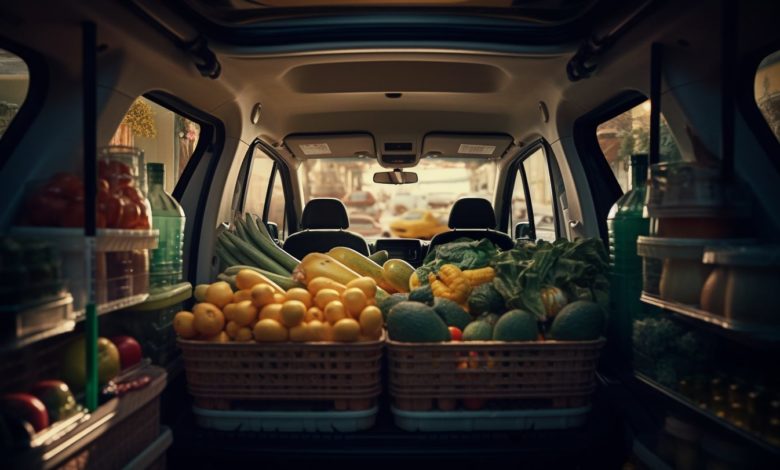Reinventing delivery – is driverless delivery the future?
As retailers are looking to digitally transform parts of their supply chain, how cost-effective, efficient and feasible are driverless deliveries?

Asda recently announced its partnership with Wayve self-driving vehicles in a year-long trial that will give the supermarket the ability to autonomously deliver groceries to over 170,000 residents across 72,000 households in London. Emile Naus, partner at BearingPoint, tells us about how these driverless vehicles can be cost-effective and efficient modes of delivery services and how these automated vehicles could work for retailers outside the supermarket space.
Can you tell me about yourself and your experience in the retail industry?
My name is Emile Naus, and I’m a partner at BearingPoint, an independent management and technology consultancy with European roots and a global reach, offering consulting, products, and capital. I worked in the supply chain in a number of different areas, but specifically in retail. Prior to BearingPoint, I worked as a long-term planning manager for Tesco distribution and then as the head of logistics strategy for M&S.
Can you tell me a bit about the Asda Wayve partnership?
Asda has teamed up with Wayve autonomous vehicles to test driverless deliveries. However, even though the vehicle will function in autonomous mode, there will still be two people in it—one for safety and the other to deliver the goods to the consumer. Because clearly, the driving factor is merely one stage of the process. In the end, it all comes down to how you deliver the goods to the buyer.
Do you think the use of technology in the form of automation simplifies operations in the retail industry?
My short response to this is, ‘Yes”. Retail and most other industries have always relied heavily on technology, and as technology advances, there will undoubtedly be more opportunities for us to use it. We’ll also look at some easier and more effective ways to use it. In short, technology will continue to advance. The key thing is that it’s not about technology, but rather the solution that technology provides. Understanding how to provide the greatest customer service and how to give a lower price are essential considerations since eventually, retailers will use those two factors as levers. Technology only serves as a facilitator for them.
Do you think automated delivery options will ever replace the traditional ones?
Will it replace it? Probably not for quite some time. Will they enhance it? Almost certainly, yes. There are two dynamics from a retail standpoint. One is that they are attempting to promote e-commerce, home delivery, and service elements while, at the same time, all of the merchants are having financial difficulties. Offering delivery services to a customer is naturally an expensive method. For instance, the retailer isn’t very involved when a customer drives or walks to a traditional supermarket because they walk around collecting all the products they need, and then at the self-service checkout point, they scan the items through the till as well. As a result, it has relatively low operational costs.
In terms of driverless deliveries, you’re now going to have somebody walking around the warehouse collecting your order. You are also going to have somebody drive those products to you. As a result, the approach has several challenges in terms of cost. Retailers are consequently actively exploring how to use technology and reduce costs simultaneously. They need to be careful about the balance between the service they offer and the cost.
If the adoption of driverless deliveries were to become more widespread, do you think it would reduce retailers’ delivery costs?
Yes, that’s the key driver. If you think about this from the retailer’s angle, the objective is to get your order to the customer. The fact that somebody’s got to sit in the vehicle and drive it is quite an expensive way of doing that.
The big concern is that when you get to the customer, there is still a manual process of getting the product out of the vehicle and delivered to the customer, and sometimes the product has to be delivered inside the house. So that is not automated, and therefore, at the moment, a driverless vehicle probably isn’t a massive cost benefit because you still need somebody to make the final delivery. But all of them will see this as a step towards taking that transaction out.
These cars also come with software that allows them to function the way they have to. So, the cost of this software is quite high, as there is a lot of effort that goes into making sure that software is functional and safe. It’s a big one-time investment. But I think retailers are looking at it as a way to save money. However, it is doubtful it will help save money this year or next year, particularly if you still need somebody in the vehicle to make the final delivery.
Do you think the use of these automated vehicles would mean fast and efficient delivery services?
Efficient, almost certainly, yes. Whether it would mean faster deliveries is an interesting question. From the viewpoint of customers, who recognise value, it is truly debatable. The current risk is that the retailers are going beyond what the customers genuinely want. BearingPoint has conducted research on what customers are willing to pay for deliveries on a number of occasions during the past ten years. And what’s truly intriguing is that most customers choose to wait a little longer rather than pay for delivery. Therefore, there is a worry that customers are virtually being overserviced, and the risk for merchants is that once people become accustomed to a service, it may be very challenging to remove it. There is a challenge, so to speak, but in the end, there will be a factor where, as it becomes more effective, the expenses will go down and the service may even be increased.
Does the consistent size of the Asda driverless cars limit their use given that parcels can vary in size?
That’s absolutely right. Asda has gone with effectively normal cars that are very limited in size, and I suspect that’s very much a technology proof of concept. A grocery delivery van for home delivery at a typical supermarket doesn’t actually take that many orders every time they go out. There are tiny robots that are being tested in Milton Keynes that also take small amounts of orders and are more focused on perhaps close distances. In these situations, the automated vehicle serves its purpose.
Now, you take the other extreme when you have a furniture delivery. I believe there are two main issues at play here. The first is that because the vehicle is a standard size, it cannot accommodate the furniture. Getting the furniture into the customer’s home is the second issue with delivery. The delivery team that actually delivers the product without causing damage to the customer’s home possesses an incredible amount of skill. Every delivery driver has attended a training facility set up for them to show them how to do it safely and without harming the furniture or removing the paint from the walls. I suspect that will probably be automated a long time from now.
Would these driverless deliveries also work for retailers outside the supermarket space?
I think the short answer is probably yes, but you’ve got slightly different challenges. For instance, if you have a food delivery, as mentioned earlier, there are the tiny robots that are being tested in Milton Keynes who take orders in small quantities, so that works quite well for that.
In the field of clothing or fashion, the parcels are often compact boxes and have a very uniform size and shape. There are definitely some options available. The real issue with that process, though, is returns. So, the clever thing is not just to make the delivery but also to make the return at the same time, and that’s a much bigger process. That’s not just about how you look at the delivery; you look at the total process of the customer receiving the product.
Then, in terms of wider and larger items, such as transporting refrigerators and freezers, you have a really delicate commodity. Therefore, some level of skill is required. Additionally, you frequently have to remove outdated equipment. Thus, automating the delivery in the truck is not as straightforward as it first appears. However, given that technology has been applied in this field over the past 30 to 40 years, one thing is for certain: as technology advances, more opportunities for operational improvement will arise. In my opinion, the risk is that consumers solely consider price, while truly clever people consider how to strike a balance between cost and service.
Where do you see the future of delivery in the next five to 10 years?
I wish I had the perfect answer to that. Automation, in my opinion, will be important. The use of general technology to streamline processes will be important. Additionally, the concept of service will be expanded to include the entire process, not just what the vehicle is doing. There is also an open question about the effective use of lockers. I believe you could have the equivalent of a locker at your house. So, when your delivery arrives, the driver has access to a coach and can open the locker or put the parcel in, but cannot remove it. Because the biggest challenge with home deliveries is that customers are not at home, the product can’t be left on the doorstep, or if it is left on the doorstep, it disappears or gets wet. Either way, it is a customer service failure, and this is where the balance of service and cost becomes really important.



